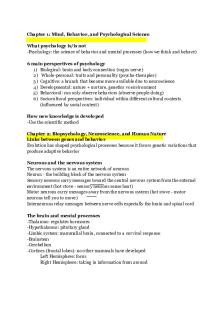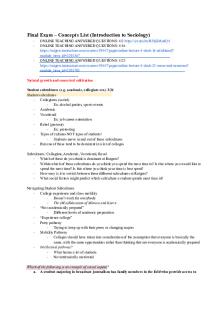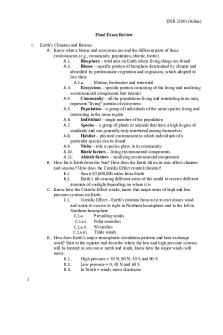Intro to law IA3 final - copped a 28/40 PDF

| Title | Intro to law IA3 final - copped a 28/40 |
|---|---|
| Course | Intro to law |
| Institution | Queensland University of Technology |
| Pages | 6 |
| File Size | 173.3 KB |
| File Type | |
| Total Downloads | 85 |
| Total Views | 126 |
Summary
copped a 28/40...
Description
Case Note: Namoa v The Queen [2021] HCA 13
Material Facts of the Case On 23 July 2018 the Crown filed an indictment charging Alo-Bridget Namoa and her husband Sameh Bayda on the terms that between 8 December 2015 and 25 January 2016 they conspired with each other to do acts in preparation of or planning to do a terrorist attack.1 The Conspiracy was evident as there was text messages with Bayda found on her phone regarding acts of violence against non-Muslims, as well as a hunting knife, shahada flag and instructions for making a bomb detonator found in her bag.2
Prior to the trial, Namoa and Bayda both applied for an order permanently staying the charge of conspiracy based on the grounds that s.11.5 of the Criminal Code ousts spouses alone from committing the crime of conspiracy.3 This would apply to Namoa and Bayda as they got married on 25 December 2015. After hearing their Argument, on 10 September Justice Fagan rejected their application for a stay.4 On 5 October 2018, Namoa was found guilty on one count of conspiring to do acts in preparation for a terrorist attack under ss.11.5 and 101.6(1) of the Criminal Code (Cth).5
Namoa then bought an appeal to the Court of Criminal Appeal (CCA) of the Supreme Court of New South Wales arguing that the offence charged was wrongful because s.11.5 did not apply to a conspiracy between spouses alone. The CCA rejected this argument and dismissed her appeal on 6 April 2020.6 1 Apellants written Submissions - Namoa (No. 27A). (2020, December). Zali Burrows. https://cdn.hcourt.gov.au/assets/cases/08-Sydney/s188-2020/Namoa-Queen_App.pdf 2 Kidd, J., 2021. Teen facing terror charges 'found with hunting knife'. [online] Abc.net.au. Available at:
[Accessed 3 June 2021]. 3 Namoa v The Queen [2021] HCA 13 [7] 4 Namoa v The Queen [2021] HCA 13 [7] 5 Apellants written Submissions - Namoa (No. 27A). (2020, December). Zali Burrows. https://cdn.hcourt.gov.au/assets/cases/08-Sydney/s188-2020/Namoa-Queen_App.pdf 6 Apellants written Submissions - Namoa (No. 27A). (2020, December). Zali Burrows. https://cdn.hcourt.gov.au/assets/cases/08-Sydney/s188-2020/Namoa-Queen_App.pdf
Namoa appealed this decision to the High Court of Australia. She claimed in the appeal that there is a common law rule that spouses alone cannot conspire and that this rule affects the meaning of ‘Conspires” and “Conspiracy”.7 The appeal particularly referred to R v LK and overseas case law, suggesting that the previous appellate court failed to consider this as a common law rule.8
On 14 April 2021, the High Court of Australia Dismissed her appeal as it was concluded that the interpretation of s 11.5(1) is not affected by any common law rule. Therefore, it was found that a husband and wife alone are separate people and may be found guilty of conspiracy.
Issues Involved
(i)
Is there a relevant common law rule in Australia which specifies that spouses alone cannot conspire?
(ii)
Does R v LK make it clear that the words “conspires” and “conspiracy” in s.11.5 of the Criminal Code (Cth) import an established common law rule that spouses alone cannot conspire?
(iii)
Is the overseas case law raised in the appeal applicable persuasive law to Namoa v The Queen?
(iv)
Does the interpretation of the s.11.5(1) of the Criminal Code (Cth) apply to spouses who agree between themselves to commit an offence against the law of the Commonwealth?
7 Namoa v The Queen [2021] HCA 13 [12] 8 Namoa v The Queen [2021] HCA 13 [12]
Judicial Reasoning Kiefel CJ, Gageler J, Keane J, Gordon J, Edelman J and Steward J all agreed with Gleeson J in his decision.9
The Judicial reasoning of Gleeson J: Justice Gleeson first established whether, in Australia, there is any common law rule that prohibits spouses alone from being able to conspire. Justice Gleeson highlighted that s.11.5(1) refers to “a person who conspires with another person”.10 Justice Gleeson acknowledged that the definition of a “person” in the dictionary to the code is as follows: “person includes commonwealth authority that is not a body corporate, and another has a corresponding meaning.”11 Justice Gleeson then concluded that a “person” and “another person” includes a husband and wife as they are two different persons and there is no existing Australian common law that spouses are a “single legal personality”.
Justice Gleeson then decided whether R v LK can be applied to the interpretation of “conspiracy” and “conspire” under s.11.5 of the Criminal Code (Cth). Justice Gleeson concluded that in R v LK, there was no common law rule that relates to spouses as an aspect in the meaning of “conspiracy”. It was found that R v LK has no authority in determining whether the meaning of “conspires” and “conspiracy” incorporates a rule to do with spouses.12
Justice Gleeson considered whether the overseas case law raised in the appeal contradicts the language of s.11.5 and if it may be considered persuasive law to Namoa v The Queen. Justice Gleeson considered the following cases raised by the appellant and how they each present different explanation to why spouses cannot conspire.
9 Namoa v The Queen [2021] HCA 13 10 Namoa v The Queen [2021] HCA 13 [14] 11 Namoa v The Queen [2021] HCA 13 [15] 12 Namoa v The Queen [2021] HCA 13 [17]
The appellant raised R v McKechie which was a case heard before the New Zealand Court of Appeal. It was held in this case that “at common law, as regards a charge of conspiracy, a husband and wife are not two persons but only one”.13
Justice Gleeson considered the Canadian case Kowbel v The Queen which held that “every one is guilty of an indictable offence”14. However, it was agreed upon that the words “every one” does not include spouses as they lacked capacity to conspire on the basis of a common law defence, “because judicially speaking they form but one person.”15
In Mawji v The Queen, the lordships identified an English criminal law that states “a husband and wife cannot alone be found guilty of conspiracy, for they are considered in law as one person”. Therefore, they concluded that the words “conspires” and “conspiracy” in English Criminal Law is not applicable to husband and wife alone.16
Finally, Justice Gleeson considered the case Midlank Bank Trust Co Ltd v Green [No 3]. It was found in this case that there is doctrine of unity between husband and wife which is an established doctrine in English law, which provides that spouses cannot be conspirators together.17 However Justice Oliver concluded that it there is no reason to apply to this rule to the tort of conspiracy because it simply gives immunity from civil liability to spouses that the unmarried do not receive even though the same law has been broken.18 This decision was upheld as Lord Denning MR explained that husband and wife alone cannot be convicted of the crime of conspiracy, however he questioned whether the same rule should be applied to the tort of conspiracy.19
After considering each of the cases, Justice Gleeson explained that in none of these cases the court considered the meaning of “conspiracy” and that they strictly followed whether there is, or was a rule denying spouses being able to conspire alone. Justice Gleeson concluded that there is no such Australian common law that is incorporated into s.11.5 of of the code by the
13 Namoa v The Queen [2021] HCA 13 [18] 14 Namoa v The Queen [2021] HCA 13 [19] 15 Namoa v The Queen [2021] HCA 13 [19] 16 Namoa v The Queen [2021] HCA 13 [20] 17 Namoa v The Queen [2021] HCA 13 [24] 18 Namoa v The Queen [2021] HCA 13 [26] 19 Namoa v The Queen [2021] HCA 13 [27]
words “conspires” and “conspiracy”. Justice Gleeson decided that it is unnecessary to consider common law for conspiracy as it does not apply to spouses.20
Justice Gleeson considered extrinsic material to assist in determining whether spouses alone are able to conspire. The extrinsic material consider was the “Gibbs Committee Report”21 which in chapter 39 stated “The review committee can see no valid reason of social policy why the rule that there can be no conspiracy between husband and wife should be retained.”22 The review committee recommended that the law should include spouses alone as being able to conspire. Justice Gleeson also thought it was relevant to consider the draft model of the Criminal Code (Cth) prepared by a committee established by the Standing Committee of Attorneys-General in 1990. The committee stated in the draft that no protection is provided for spouses and that a husband and wife can clearly be guilty of conspiring with each other.23 Justice Gleeson saw that these extrinsic materials support that spouses alone who conspire are guilty under s 11.5(1) of the Criminal Code (Cth).24
The appeal was dismissed by the High Court of Australia.25
Appellants Application for Permanent Stay of Proceedings To find the appellants application for a permanent stay of proceedings prior to the original trial decision, I went to the QUT Library website and proceeded to the law database. I then filtered the search to case law and then clicked on ‘CaseBase (Via lexis Advance Research)’. I then searched up ‘Namoa’ as it is the appellants surname. Since I saw the crown filed an indictment against Namoa in 2018 I figured the trial would have also been in 2018, so I clicked on the only case in 2018, “R v Bayda; R v Namoa (No 3)” and then downloaded the document. The New South Wales Supreme Court heard the trials26 and was given jurisdiction by s 68 of the Judiciary Act 1903 (Cth). 20 Namoa v The Queen [2021] HCA 13 [28] 21 Namoa v The Queen [2021] HCA 13 [30] 22 Namoa v The Queen [2021] HCA 13 [30] 23 Namoa v The Queen [2021] HCA 13 [33] 24 Namoa v The Queen [2021] HCA 13 [34] 25 Namoa v The Queen [2021] HCA 13 [35] 26 R v Bayda; R v Namoa (No 3) [2018] NSWSC 1381
Justice Fagan looked at previous cases in the trial to determine whether to grant a permanent stay of proceedings. Justice Fagan found that the appellants reliance in the case PGA v The Queen 2012 is affected as the case referred to a common law that has been outdated, without prior authority and lacked explanation in cases where it has been repeated.27 This allowed Justice Fagan to decide that this is a non-binding case. Justice Fagan did not consider Midlank Bank Trust Co Ltd v Green [No 3] as binding. This is because he found it odd that Justice Oliver acknowledged that the law where spouses alone cannot conspire “was a fiction which had once pervaded many fields of law abandoned in all of them… except criminal conspiracy.” Yet, Justice Oliver still decided it was “too often stated now to be in doubt”28. Justice Fagan decided that he was unable to use this case as an authority due to the “unreasoned repetition” of the rule that spouses alone cannot conspire.29 In simpler terms, Justice Fagan could see no reason to why these judges were following this rule as there is no cases to support why spouses cannot conspire.
Namoa’s application for special leave was heard on 13 October 2020 by Nettle J and Edelman J in the High Court of Australia.30
27 R v Bayda; R v Namoa (No 3) [2018] NSWSC 1381 [35] 28 R v Bayda; R v Namoa (No 3) [2018] NSWSC 1381 [36] 29 R v Bayda; R v Namoa (No 3) [2018] NSWSC 1381 [36]
30 Namoa v The Queen [2020] HCATrans 163 (13 October 2020)...
Similar Free PDFs

Dicussion 2.2 intro to law
- 1 Pages

Week 1 Intro to Law
- 4 Pages

Intro To Psych Final Exam
- 24 Pages

Final Notes - Intro to Management
- 28 Pages

Final Intro A LAS RRII
- 70 Pages

Intro to A P powerpoint
- 3 Pages

Intro to Law Notes - Weeks 1 -10
- 23 Pages

IA3 Share Based Compensation
- 3 Pages

Intro to Stats Final Study Guide
- 15 Pages

Copy of intro to africana final exam
- 26 Pages
Popular Institutions
- Tinajero National High School - Annex
- Politeknik Caltex Riau
- Yokohama City University
- SGT University
- University of Al-Qadisiyah
- Divine Word College of Vigan
- Techniek College Rotterdam
- Universidade de Santiago
- Universiti Teknologi MARA Cawangan Johor Kampus Pasir Gudang
- Poltekkes Kemenkes Yogyakarta
- Baguio City National High School
- Colegio san marcos
- preparatoria uno
- Centro de Bachillerato Tecnológico Industrial y de Servicios No. 107
- Dalian Maritime University
- Quang Trung Secondary School
- Colegio Tecnológico en Informática
- Corporación Regional de Educación Superior
- Grupo CEDVA
- Dar Al Uloom University
- Centro de Estudios Preuniversitarios de la Universidad Nacional de Ingeniería
- 上智大学
- Aakash International School, Nuna Majara
- San Felipe Neri Catholic School
- Kang Chiao International School - New Taipei City
- Misamis Occidental National High School
- Institución Educativa Escuela Normal Juan Ladrilleros
- Kolehiyo ng Pantukan
- Batanes State College
- Instituto Continental
- Sekolah Menengah Kejuruan Kesehatan Kaltara (Tarakan)
- Colegio de La Inmaculada Concepcion - Cebu





